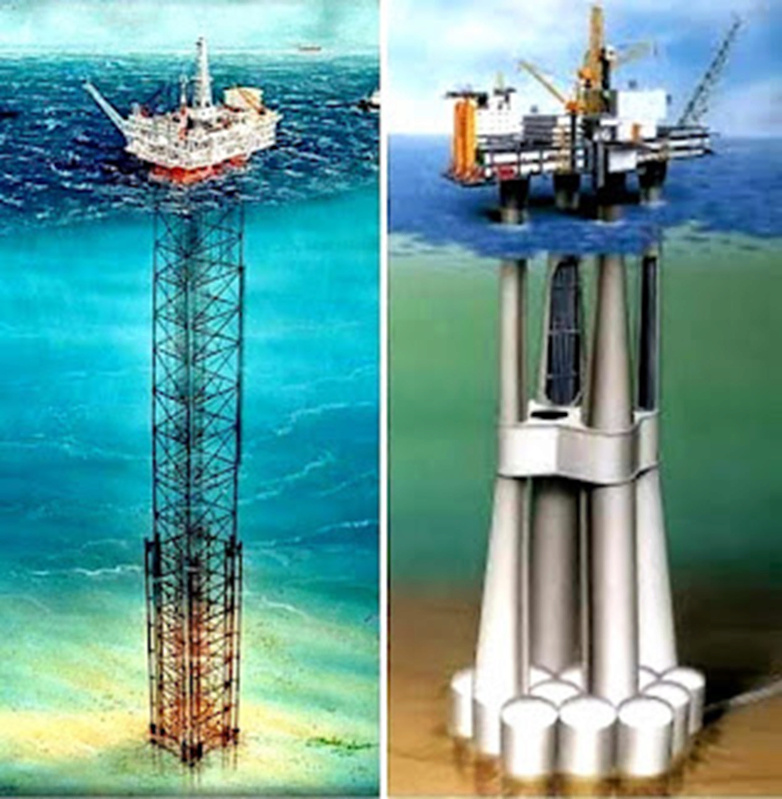?How is natural gas extracted from the sea

Extracting oil and gas from deep seas
How to extract oil and gas from the depths of the sea, how to know where natural gas or oil is located in the sea, and when was the first exploration for energy sources in the sea and how?
Humans have known natural gas and oil for thousands of years, and natural gas does not differ much in its composition from petroleum, as they both arise under the same conditions. Both natural gas and oil are often found in underwater fields, or underground, and natural gas contains plankton, which are organisms. They are not visible to the naked eye, such as algae and primitive organisms that accumulated over the years in the layers of the earth and oceans, and the remains were compressed under the sedimentary layers. As a result of pressure and heat, these remains and organic materials were transformed after thousands of years into natural gas and petroleum.
Since natural gas is considered lighter than petroleum, it forms a layer higher than the petroleum layer, and it is a gas that covers the petroleum, as it accompanies and accompanies it, and in this case it is called associated gas.
How to find out where natural gas or oil is located in the sea:
Surface features such as oil or natural gas seeps or even underwater craters caused by gas leaks provide key evidence of hydrocarbon generation (whether surface or deep underground).
But most exploration operations rely on very complex techniques to detect and determine the presence of hydrocarbon using sound equipment, through which oil companies determine drilling sites that are likely to produce oil.

Also using geophysics for exploration, areas believed to contain hydrocarbons are initially subjected to a specific gravity survey, magnetic survey, passive seismic activity, or regional seismic surveys to discover large-scale features of subsurface geology. Important features (which are called Possible positive indicators) for further seismic searches, which work on the principle of the time it takes for reflected sound waves to move through materials (rocks) of different densities and using the depth conversion process to determine infrastructure features.
Finally, after confirming the presence of gas or oil, an exploratory exploration well is drilled in an attempt to definitively determine the presence or absence of oil and gas.
How to extract oil and gas from the deep sea:
Oil and gas wells can be drilled and extracted from practically anywhere in the world, whether on land, at sea, or in swamps, and from the equator to the frozen polar regions. It is known that oil and gas reserves on land have become limited, and it has become difficult to find new areas containing oil on land. Since the surface area of the Earth is more than 70% water, it was natural to search for hydrocarbons at the bottom of the sea and extract them from it.
Explorers faced great difficulties in investigating the locations of oil in coastal and marine areas in the beginning, but the amazing progress in exploration and drilling techniques in recent years helped develop and accelerate the processes of extracting oil from the sea to a great degree, starting from exploration and exploratory drilling to production and storage in the sea. Marine areas no matter what obstacles, despite sea currents and storms.
It is worth noting that the first productive well drilled in the world was in the town of Titusville in the state of Pennsylvania in the United States of America in the year 1859 AD, and thirty-eight years after that date, that is, in the year 1897 AD, the first marine well was drilled.
The term hydrocarbon exploration is used to refer to oil and gas exploration, which is carried out by petroleum geologists and geophysicists to search for hydrocarbon deposits under the Earth’s surface that exist in the form of oil and natural gas.

Exploring for oil or gas is a very expensive and dangerous process. Marine exploration operations and in remote areas are generally carried out by very large companies or by state governments.
Accessing oil and gas deposits is also dangerous, but if the drilling, assembling and transportation process is done properly the benefit will be greater, but if things go wrong the results can be fatal to both the workers and the surrounding environment.
As for how the gas is extracted, it is extracted from wells that are very similar to oil wells, where there are clusters of natural gas wells far from the coast, and the natural gas is transported via pipes from production platforms to a specific collection point on the shore, and then transported to laboratories. Refining is where it is purified. Natural gas is purified by removing water and other liquids from it, and then the gas is passed through a cooler to liquefy the petroleum, and it is filled in bottles as fuel for heaters, cooking, and homes. As for the remainder of the gas, it is pumped through a supply network or liquefied through Cooling, compression and marketing it as liquefied natural gas.
Oil platforms are huge structures on floating floors used to produce oil and gas from the deep sea.
The platform is a village on a small island that contains everything the workers need, including machines, equipment, housing, food, drink, and electricity generators.

Workers and what they need are transported by helicopter or by boat if the distances are short, and a distinction must be made here between drilling platforms and production and storage platforms.
Platforms are built in ship factories, then shipped to the drilling site where they are installed and installed. These platforms vary according to their size, but it is known that their size and technology are directly proportional to the depth of the water.
Source: websites

